From Ancient Pulque to Today
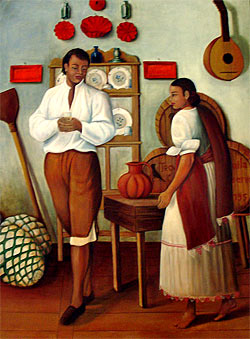 Tequila's history and Culture.
Tequila's history and Culture.
The word Tequila is ambiguous. It is said to be a term derived from the ancient Nahuatls, the region's original inhabitants, and has being variously interpreted as "the place of harvesting plants," "the place of wild herbs," "place where they cut," "the place of work" or even "the place of tricks." More specifically, according to Jose Maria Muria, the word comes form the Nahuatl 'tequitl' ( meaning to work, duty, job or task) and "tlan" (place). Others suggest the word is a corruption of "tetilla" because the regions local volcano looked like a small woman's breast. Other sources say it is a corruption of the name of the natives - "Ticuilas" or "Tiquilos". In a sense, all of the above meanings are valid, for tequila is the name not only of a spirit, but of a town and a valley.
"Maguey" (pronounced 'mah-gay') - another name for the agave plant from which tequila is distilled - is not a native term, but was imported from the Antilles with the first known reference appearing in 1533. The Nahuatl people called the plant "metl" or "mexcametl", from which the word mezcal is derived. For them it was a divine plant, worshipped as the earthly representation of the goddess Mayaheul, who had 400 breasts to feed her 400 children. Other indigenous people had different names for the plant: it was 'carnaba' or 'tocamba' to the Purepecha; 'guada' to the Otomi.
Historically, the Agave plant has played a much larger role than just being the source of an alcoholic drink. It was aptly described as "el arbol de las maravillas" (the tree of marvels) in a 1596 history of the Indians of Central America. Human remains dating back 9,000 years show its leaves, a hemp-like fibre, being used for mats, clothing, rope and paper. And of course, it was also the source of the nutrient and vitamin rich brew, "pulque".
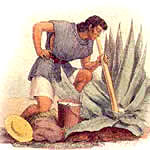 Distillation of pulque into something stronger may have started by the Conquistadors as early as the 1520's. The Spanish were accustomed to drinking weak wine and beer with meals for in Europe water was often a dangerous drink, unpurified and teeming with bacteria and parasites. In his first letter home, the Conquistador Cristobal de Onate wrote to King Carlos V about sugar obtained from agave: "From these plants they make wine and sugar, which they also sell." In the 16th century, the Franciscan friar, Torbio de Benavente, wrote about the drink 'mexcalli.' Eager to maintain the market for Spanish products, in 1595, Phillip II banned the planting of new Agave pastures in Mexico.
Distillation of pulque into something stronger may have started by the Conquistadors as early as the 1520's. The Spanish were accustomed to drinking weak wine and beer with meals for in Europe water was often a dangerous drink, unpurified and teeming with bacteria and parasites. In his first letter home, the Conquistador Cristobal de Onate wrote to King Carlos V about sugar obtained from agave: "From these plants they make wine and sugar, which they also sell." In the 16th century, the Franciscan friar, Torbio de Benavente, wrote about the drink 'mexcalli.' Eager to maintain the market for Spanish products, in 1595, Phillip II banned the planting of new Agave pastures in Mexico.
First Known Tequilas
Don Pedro Sanches de Tagle, Marquis of Altamira, the 'father of tequila,' established the very first tequila factory in his Hacienda Cuisillos in 1600. Soon after, in 1608, the governor of New Galicia imposed the first taxes on mezcal wine. By 1621, "wines of mezcal" were being regularly supplied to nearby Guadalajara and the first references to an "abundant" mezcal harvest appeared in local records. The first reliable reference to the spirit comes from this year, in the 'Description of New Galicia' (Descripcion de la Nueva Galicia) by Domingo Lazaro de Arregui. In 1636, governor Don Juan Canseco y Quinones authorized the distillation and manufacture of mezcal wines, which made it easier to collect taxes on production - taxes which increased significantly in the next decade as the government tried to generate funds for public works. In 1651, Spanish doctor Jeronimo Hernandez mentioned that tequila (mezcal) was used for medicinal purposes, including rheumatic cures by rubbing tequila on the affected parts of the body.
First Exports
After the Conquest, the area around today's Jalisco state was called New Galicia by the Spanish conquerors. The community we now know as Tequila officially became a village in 1656. In the 1700's, mezcal 'wines' became an important product for export because the town of Tequila lay on the route to the newly opened Pacific port of San Blas. Mezcal wines from the region developed a reputation for quality even in urban Mexico City. But in 1785, the production of all spirits, including mezcal and pulque, were banned by the government of Charles III to favour and promote the importation of Spanish wines and liqueurs. Officially, production was halted but went underground until 1792 (possibly 1795), when King Ferdinand IV ascended the throne and lifted the ban. Prohibition may have led the native population to bake the agave underground -literally - a practice that continues today in mezcal production. Authorities eventually realized taxation, rather than prohibition, was the better means of control. The University of Guadalajara was paid for in part by taxes on mezcal wines.
J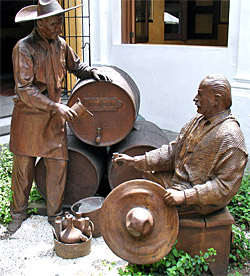 ose Cuervo - Tequila Pioneer
ose Cuervo - Tequila Pioneer
The first licensed Tequila producer was Jose Antonio Cuervo ("Joe Crow" of the Cuervo Montano family), who secured the rights to cultivate a parcel land from the King of Spain in 1758. He acquired the property - the hacienda Cofradia de las Animas - from Vicente de Saldivar, who was already running a small, private distillery on the land. In 1795, his son Jose Maria Cuervo got the first license to produce mezcal wine from the Crown and founded the first official Mexican distillery. His Casa Cuervo (or Taberna de Cuervo) proved very profitable. In 1812, Jose died and left his holdings to a son, Jose Ignacio, and a daughter Maria Magdalena. She married Vicente Albino Rojas. Her dowry was the distillery. Vicente changed its name to 'La Rojena' and increased production. By mid-century Curevo's fields had more than three million agave plants. He died before the railroads were built into the area and Jesus Flores took over the distillery. Flores was the first distiller to put tequila into bottles in the late 19th century when others were still using barrels. His first bottled tequila was sold in 1906. At the same time, he moved Cuervo to a new, larger site called La Constancia, to take advantage of the transportation network the new railroad offered. By 1880, Cuervo was selling 10,000 barrels of its tequila in Guadalajara alone.
In 1900, after Flores had died, his widow married the administrator, Jose Cuervo Labastida, and soon the product became known as 'Jose Cuervo.' The taberna returned to its original name. (Today Cuervo is the world's largest manufacturer of tequila). It was common to name the tabernas, or distilleries, after their owners, adding 'eña' to the name: La Florena, La Martinena, La Guarrena, La Gallardena and La Quintanena are examples. Later, the names would reflect values or convictions (La Preservancia (Perserverance) and La Constancia (Constancy).
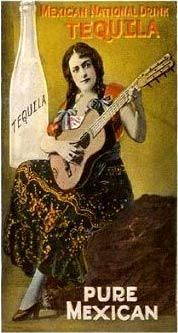 Challenge & Response
Challenge & Response
Other distilleries were established during the 19th century, some of them flourishing, others closing. During Mexico's War of Independence in the early decades of the 19th century, tequila became a stock item among the soldiers on all sides of the conflict. The war with the United States in the mid-to-late 1840's also gave American soldiers exposure to tequila, but the distribution network did not allow it to grow.
In the 1880s, the rapid growth of the railroads across North America helped spread tequila further. Growth was aided by the relative stability during the 35-year rule of Porfirio, during which the tequila industry stabilized and matured. By 1893, "mezcal" was regularly exported into the USA and won an award at the Chicago World's Fair the same year. Meanwhile, distilleries in Jalisco were slowly switching from making aguardiente (sugarcane based spirit) to tequila. Around this time, the product from Jalisco - mezcal of Tequila - became known simply as 'tequila' in the same way as brandy made in a certain region of France became known as 'Cognac'. A reference to mezcal wine as 'tequila' was first recorded by the French traveller Ernest de Vigneaux, in 1854, but this was decades before it was in common use.
By the turn of the century, many companies had started selling tequila in bottles. Naturally this was a move that helped increase sales. Around this time the number of distilleries in Jalisco grew to almost 100, then dropped precipitously to only 32 by 1910 when the Diaz regime collapsed and the country was thrown into political and military turmoil.
Tequila gained national importance during the Revolution in the early part of this century when it became a symbol of national pride and the passion for French products was replaced by patriotic fervour for Mexican goods. Tequila became associated with the hard-riding rebels and gun-slinging heroes of the period (c.1910-1920). At the same time, tequila was also smuggled to American troops guarding the border, helping spread it to nearby U.S. states.
Modern production techniques, including cultivated yeasts, were introduced in the late 1920s when peace returned. The decision to use non-agave sugars (usually cane sugars) in fermentation along with those from the agave was made in the 1930s, a fateful move that changed the industry and affected its reputation for decades. By 1964 distillers were allowed to employ other sugars up to 30%, which soon climbed to 49%.The blander product, however, was more palatable to American tastes and helped boost export sales, particularly through prohibition. Similarly, during World War II, tequila rose in popularity in the USA after spirits from Europe became hard to get. Production grew and Agave fields expanded 110 per cent between 1940 and 1950. In 1948, exports fell to an all-time low, while national consumption grew - thanks in great part to the positive portrayal of tequila as a macho drink of heroic rancheros in Mexican movies from the 1930s to 1950s.
Efforts to regulate the industry also intensified, with two groups created between the two world wars, eventually evolving into today's regulatory organizations. In 1944, the Mexican government decided that any product called 'tequila' had to be made by distilling agave in the state of Jalisco. The first standards for tequila were laid out in 1947 and have been upgraded and revised ever since.
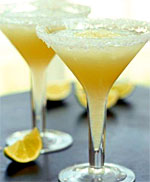 Cocktails
Cocktails
The first major boost to Tequila sales in the rest of the United States came in the late 1940s when the Margarita cocktail [right], a blend of Tequila, lime juice, orange liqueur, and ice was invented. Its origins are uncertain, but Hollywood actors and cocktail parties in California and Mexican resorts seem to be involved in most of the genesis stories. It is known that crooner and actor Bing Crosby was so taken with one particular brand of Tequila, Herradura, that he teamed up with fellow actor Phil Harris to import the brand into the United States. The Margarita, along with the Tequila Sunrise and the Tequila Sour, have become highly popular in the United States; in fact, it is claimed by many in the liquor industry that the Margarita is the single most popular cocktail in the nation. In the 1970's, when balladeer Jimmy Buffet sang of "Wasting away in Margaritaville," the success of the song enticed millions more Americans to sip from the salt-rimmed Margarita glass.
Tequila's popularity grew again in the 1960's and the 1968 Olympic Games in Mexico City helped worldwide exposure. But it wasn't until the growing population of American tourists and baby-boom visitors to Mexico started to discover the premium brands in the mid 1980s, that tequila moved from a 'party' drink to status symbol among the cocktail set. This perception was augmented by the release of Chinaco, the first super-premium tequila sold in the USA in 1983.
Appellation of Origin Designation
In 1974, tequila gained international recognition and acceptance of tequila as a product originating only in Mexico - the AOC, or Appellation de Origin Controllee was published in 1977. Mezcal is now also protected by an AOC designation. However, it wasn't until 1996 that Mexico signed an international agreement for all countries to recognize tequila as a product from only a certain area in Mexico. The European Union signed a trade accord in 1997, recognizing Mexico as the sole producer of tequila. South Africa recently threatened to ignore this international agreement by allowing a firm in Graaff-Reinet to open a 'tequila' plant in that country in 1998, using blue agave grown locally from Mexican stock that had invaded South African ecosystems. Although they planned to call it 'tequila', their product would have only 10% agave, the remainder was to be other alcohols and sugars. Protests from the Mexican government finally deterred the plans of Reinet Distillers, and their product was re-named 'Spirit of Agave'. Similar efforts to make tequila outside Mexico have been made in Japan and Spain. In response to this , Mexican tequila manufacturers opened trade offices in Madrid and Washington to protect the use of the name tequila and promote the spirit in export markets.
In order to further guarantee tequila's provenance and quality, the Normas Oficial Mexicana (N.O.M.) was established in 1978 to regulate all of the agricultural, industrial and commercial processes related to tequila. There are now only five 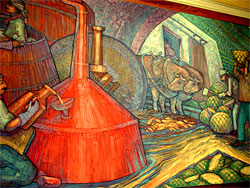 regions where tequila can be legally made, most within the northwest part of the country and within 100 miles of Guadalajara.
regions where tequila can be legally made, most within the northwest part of the country and within 100 miles of Guadalajara.
Most are within the state of Jalisco (including the communities of Tequila, Tepatitlan, Guadalajara, Amatitan, Arandas, Arenal, Capilla de Guadalupe, Zapotlanejo and Atotonilico). The rest are in the adjoining states of Guanajuato, Michoacan, Nayarit and the northeastern state of Tamaulipas. The areas are all semi-arid with clay soils, mostly plateaus and highlands. In Jalisco's Tequila region, the fields crowd the slopes of two extinct volcanoes.
By 1980, there were 33 distilleries cultivating 30-35,000 hectares and employing 5,800 people to make tequila. That has grown to about 70 distilleries all but two are in Jalisco, the main outsider being Chinaco in far-away Tamaulipas on the Gulf coast. More than 50,000 hectares of agave are under cultivation, and the workforce is around 38,000. Although the US has been the largest consumer for many years, Mexican consumption has grown apace.
